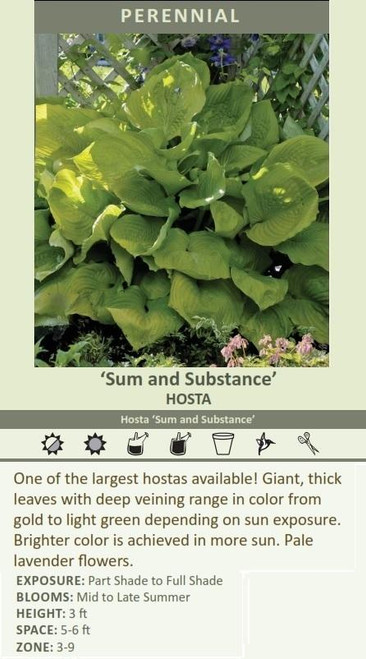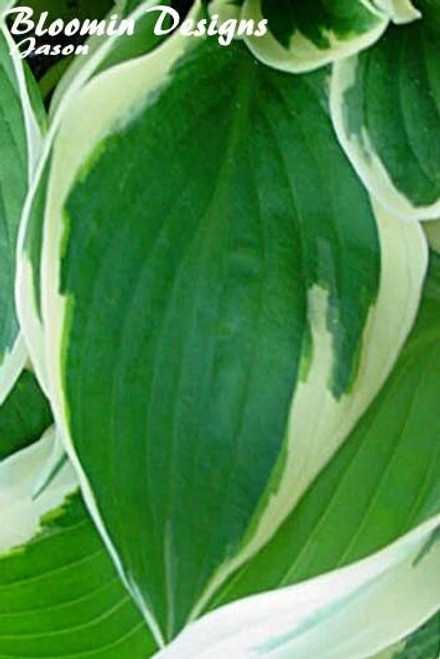Product Description
SUM and SUBSTANCE Hosta (Arden 1980) (4) 1-gallons
- One of the largest hostas available today, with 16' broadly ovate leaves and a huge, mounded form
- Leaf color varies with the amount of available sun from light green to chartreuse to gold; prefers 1/4 to 3/4 day of sun
- Leaves are of good substance, corrugated, and glossy, giving them good slug resistance
- Pale lavender, bell-shaped flowers on 48' scapes in mid to late summer
- Exhibits greater sun tolerance.
Very large.
Heart-shaped golden chartreuse leaves, which becomes more puckered with maturity. Leaves are of good substance, corrugated, and glossy, giving them good slug resistance.
Mature size: 60 inches wide by 36-inch height.
White flowers on 72-inch scapes.
Parentage: Unknown.
Hosta of the Year 2004.
American Hosta Society Multiple Award Winner.
Hosta 'Sum and Substance' is a truly magnificent hosta, renowned for its impressive size and vibrant foliage. This vigorous grower forms a large, mounding clump of huge, heart-shaped leaves that emerge a light green and gradually mature to a stunning chartreuse-gold, especially with sufficient sunlight. The leaves are thick, slightly corrugated, and have a beautiful, glossy sheen, making them quite slug-resistant. In mid to late summer, 'Sum and Substance' produces tall scapes adorned with fragrant, pale lavender to near-white flowers, adding another layer of interest to this already impressive plant. This hosta is a true statement piece, perfect for adding a touch of grandeur to any shade garden.
Details:
- Mature Size: 2-3 feet tall, 5-6 feet wide
- Leaf Size: 16-20 inches long, 12-15 inches wide
- Flower Color: Pale Lavender to Near-White
- Bloom Time: Mid to Late Summer
- Growth Habit: Mounding
- Sunlight: Partial Shade to Full Shade (Best gold color in morning sun or filtered shade)
- Soil: Moist, well-drained
- Hardiness Zones: 3-8
Planting and Care:
- Planting: Choose a location with partial to full shade. While 'Sum and Substance' can tolerate some sun, its best gold coloration is achieved in bright, filtered shade or with morning sun. Ensure the soil is moist and well-drained. Amend the soil with compost or other organic matter before planting. Dig a hole slightly larger than the root ball and plant at the same depth as the container. Space plants 3-4 feet apart to allow for their mature size.
- Watering: Keep the soil consistently moist, especially during dry spells. Water at the base of the plant to avoid wetting the 1 leaves, which can increase the risk of fungal diseases.
- Fertilizing: Apply a balanced fertilizer in early spring as new growth emerges. Avoid over-fertilizing.
- Mulching: Mulch around the plants with shredded bark, compost, or pine needles to retain moisture, control weeds, and protect the crown.
- Pest and Disease Control: Be vigilant for slugs and snails, which can be a threat to hostas. Use appropriate control measures like slug bait or traps. Hosta Virus X (HVX) is also a potential issue; purchase plants from reputable sources and discard any plants exhibiting symptoms of the virus.
- Division: Divide clumps every 3-5 years, or as needed, to prevent overcrowding and rejuvenate the plant. Division is best done in spring or fall.
Special Considerations:
- 'Sum and Substance' makes a spectacular focal point in shady gardens, borders, or woodland settings.
- Its large, bold leaves provide a dramatic backdrop for other shade-loving plants.
- It is an excellent choice for container gardening, but ensure the container is large and sturdy enough to accommodate its mature size and weight.
- The gold coloration is most intense in bright, filtered shade or with some morning sun. In deeper shade, the leaves may be more chartreuse.
- 'Sum and Substance' is known for its slug resistance due to its thick leaves.
Leaf color varies with the amount of available sun from light green to chartreuse to gold; prefers 1/4 to 3/4 day of sun. One of the biggest and most popular Hostas due to its mammoth potential.
If you think yours is big, the record is 9 feet wide.
(4) 1-gallon containers ready to plant, plants may be trimmed for shipping,
Other Details
The most important part of the plant is its root system. Healthy roots are the foundation of a healthy, vibrant plant. The type of plug container used is based on the specific needs of the plants. Perennials offered as bare root traditionally perform better when planted as bare root.Planted in a specialized mix, potted plants have well established root systems. Top growth stage will vary depending on the current life cycle and time of year when shipped. In Winter and early Spring dormant plants may be shipped. Dormant plants may be planted right away, even before the last frost date.
Most bare root varieties are field grown for at least one season, though Hemerocallis and Hosta are grown for two seasons. The bulk of the soil is removed during the harvesting process and the tops of most varieties are trimmed back to the crown. They are graded, packed in shredded aspen or sphagnum moss and stored in freezers until ready to be shipped.
See our Container Sizes and Bare Root Perennials pages for more information.
Plant information and care is provided in the Overview section, Plant Genus Page and general information is provided in the Planting Care & Guides. Additional questions can be asked on each Plant page.
Plant Spacing: Using the maximum mature spread or width of a plant to guide spacing, ensures space to grow to full size. To fill an area sooner, plant them closer together. Just remember, future thinning or transplanting may be needed.
Water: Keep a close eye on newly planted perennials, especially throughout the first growing year. Most early plant loss is due to too much or too little water!

















